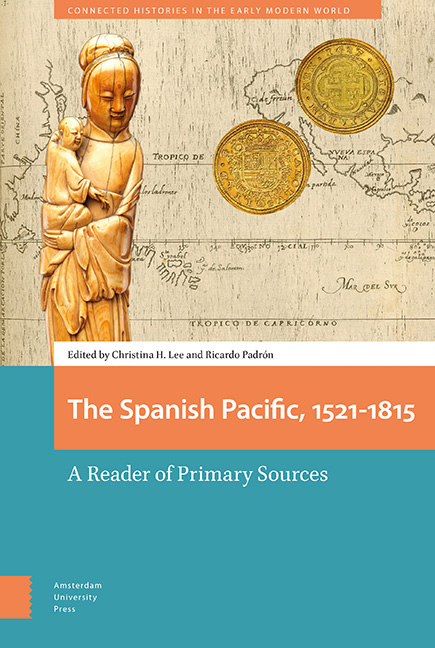Book contents
- Frontmatter
- Contents
- Abbreviations
- Acknowledgements
- Introduction
- 1 An Early Transpacific Account of the Spice Islands by Andrés de Urdaneta (1536)
- 2 Domingo de Salazar’s Letter to the King of Spain in Defense of the Indians and the Chinese of the Philippine Islands (1582)
- 3 Juan Cobo’s Map of the Pacific World (1593)
- 4 A Royal Decree of Philip III Regulating Trade between the Philippines and New Spain (1604)
- 5 Manila’s Sangleys and a Chinese Wedding (1625)
- 6 Don Luis Castilla Offers to Sell Land in Manila (1629)
- 7 Idolatry and Apostasy in the 1633 Jesuit Annual Letter
- 8 The Will of an Indian Oriental and her Chinos in Peru (1644
- 9 Francisco de Combés’s History of Mindanao and Jolo (1667)
- 10 Between Fiction and History in the Spanish Pacific The Misfortunes of Alonso Ramírez (1690)
- 11 A Moluccan Crypto-Muslim before the Transpacific Inquisition (1623–1645)
- 12 Constitutions and Rules of the Beatas Indias (1726)
- 13 The Poetics of Praise and the Demands of Confession in the Early Spanish Philippines: Notes and Documents
- 14 The Pacific Theater of the Seven Years’ War in a Latin Poem by an Indigenous Priest, Bartolomé Saguinsín (1766)
- 15 A Prohibition on Digging Up the Bones of the Dead (1813)
- Index
8 - The Will of an Indian Oriental and her Chinos in Peru (1644
Published online by Cambridge University Press: 20 November 2020
- Frontmatter
- Contents
- Abbreviations
- Acknowledgements
- Introduction
- 1 An Early Transpacific Account of the Spice Islands by Andrés de Urdaneta (1536)
- 2 Domingo de Salazar’s Letter to the King of Spain in Defense of the Indians and the Chinese of the Philippine Islands (1582)
- 3 Juan Cobo’s Map of the Pacific World (1593)
- 4 A Royal Decree of Philip III Regulating Trade between the Philippines and New Spain (1604)
- 5 Manila’s Sangleys and a Chinese Wedding (1625)
- 6 Don Luis Castilla Offers to Sell Land in Manila (1629)
- 7 Idolatry and Apostasy in the 1633 Jesuit Annual Letter
- 8 The Will of an Indian Oriental and her Chinos in Peru (1644
- 9 Francisco de Combés’s History of Mindanao and Jolo (1667)
- 10 Between Fiction and History in the Spanish Pacific The Misfortunes of Alonso Ramírez (1690)
- 11 A Moluccan Crypto-Muslim before the Transpacific Inquisition (1623–1645)
- 12 Constitutions and Rules of the Beatas Indias (1726)
- 13 The Poetics of Praise and the Demands of Confession in the Early Spanish Philippines: Notes and Documents
- 14 The Pacific Theater of the Seven Years’ War in a Latin Poem by an Indigenous Priest, Bartolomé Saguinsín (1766)
- 15 A Prohibition on Digging Up the Bones of the Dead (1813)
- Index
Summary
Abstract
In her 1644 will, a widow named Leonor Alvarez made arrangements for her funeral and granted freedom to four people whom she had held as slaves. Alvarez identified herself as the “Peruvian daughter of gentile parents from Oriental India.” She had been married to one Hernando Gutierrez, of Chinese origin, and the people she freed were from Africa and Asia. Leo Garofalo places this document in the context of Lima's complex racial demography, which included significant numbers of people from East, Southeast, and South Asia, both free and enslaved. The will provides a glimpse into the life or Asian men and women who had migrated either freely or by force to South America.
Keywords: colonial Lima; Peru; indios chinos; enslavement; women
The central document presented here is the 1644 will in Lima, Peru, of Leonor Alvarez from India, widow of Hernando Gutierrez of the Chinese nation (“nación chino”). Upon her death, Alvarez's will frees her four slaves from Africa and Asia, including their children, and makes one of them her sole heir and a co-executor of her will. How do we understand the presence of Asians in Spanish South America in this period? And what do the actions set in motion by Leonor Alvarez's illness and death tell us about her role in colonial Andean society? Leonor Alvarez lived in a Lima famous for the complex mix of people drawn together by colonial migration, commerce, and the slave trade. Already by the end of the sixteenth century these forces had converted Lima into a key imperial and religious administrative center as well as a commercial crossroads with a majority black population in a majority indigenous colony. Accounts by observers like Fray Martín de Murúa and Portuguese crypto-Jew don Pedro de León Portocarrero in Lima around this time mentioned the presence of people from China and India in the markets and streets. The trade items of silks, spices, porcelains, carved ivory, and other luxuries from Asia were in Lima's markets, shops, and wealthy homes and ornate churches. People also came south from New Spain's Manila Galleon trade with Asia.
- Type
- Chapter
- Information
- Spanish Pacific, 1521–1815A Reader of Primary Sources, pp. 131 - 140Publisher: Amsterdam University PressPrint publication year: 2020



